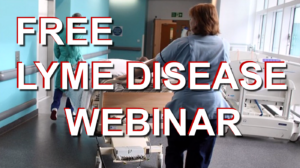Early Detection of Lyme Disease
by TVance | May 21, 2017 7:08 am
The Importance of Early Detection for Effective Treatment
Early detection is essential for effective treatment of Lyme disease. The trouble is that only about 70% to 80% of those who contract it show the telltale bulls eye rash that can distinguish Lyme from other medical conditions.
 [1]
[1]
Early stage Lyme disease
Early stage Lyme presents some diagnostic difficulties because of many of its symptoms are similar to common illnesses such as the flu, aches and pains, tiredness from overexertion, and so on. Up until recently, a large percentage of the medical community in the US didn’t believe that Lyme even existed. They thought it might be other issues such as fibromyalgia, some sort of autoimmune disorder like multiple sclerosis (MS) or rheumatoid arthritis (RA), chronic fatigue syndrome (CFS), or it is ‘all in the patient’s head.’
Fortunately, most doctors are now a lot better informed about Lyme disease, so presenting to the doctor with the typical symptoms, but also taking a full medical history, can help determine earlier than ever whether or not the person has Lyme disease.
A precise medical history
Doctors in the Northeast and Northwestern US should ask about the person’s hobbies and where they have been recently, such as hiking or camping. They should also ask whether there are pets in the house such as cats or dogs and whether they go out into wooded areas.
They should also be asked if they saw a tick attached to them, and whether or not they tried to remove it. If they tried to remove it, did they do so successfully, or might there still be tick mouth parts embedded in the skin?
If the person lives in an area where Lyme is common, or they have seen a tick, the doctor will likely not wait to start the patient on antibiotics. This is because the bacteria is a spirochete, which looks like a corkscrew or tiny snake. Because of its shape, it can insert itself into tissue and be very difficult to eradicate.
Effective treatment for Lyme
 [2]Depending on the severity of symptoms and patient allergies, doctors may recommend one or more antibiotics to try to prevent the bacteria from spreading. The antibiotics might be intravenous, by mouth, or both. Oral antibiotic treatments will usually last 2 to 4 weeks. The whole course should be taken even if the patient starts to feel better, and they should go for follow-up tests with the doctor to determine the level of bacterial activity in the blood.
[2]Depending on the severity of symptoms and patient allergies, doctors may recommend one or more antibiotics to try to prevent the bacteria from spreading. The antibiotics might be intravenous, by mouth, or both. Oral antibiotic treatments will usually last 2 to 4 weeks. The whole course should be taken even if the patient starts to feel better, and they should go for follow-up tests with the doctor to determine the level of bacterial activity in the blood.
Advanced Lyme disease
Prompt treatment is the best hope of success in eradicating Lyme before it can do serious damage. However, if the disease remains untreated, it can result in serious health issues, including:
Neurological disorders
These include a headache, stiff neck, nerve pain, ‘brain fog’, and in some cases facial nerve paralysis, commonly referred to as Bell’s palsy. The cognitive decline that results from untreated Lyme has been mistaken for dementia and Alzheimer’s disease.
Heart problems
Lyme carditis is an infection of the heart muscle which can lead to a slow or fast heart rate or irregular beats.
Eye issues
Lyme can cause a range of vision problems, from the pink eye (conjunctivitis) and blurred vision, to dry eye and more serious irritations.
Rheumatological issues
The pain in bones in joints has been compared to them feeling as though they are on fire. Along with muscle aches and fatigue, it is often mistaken for fibromyalgia and other rheumatic conditions.
Since the complications of Lyme disease can lead to a severely diminished quality of life if you suspect you have Lyme, have it checked out as soon as possible to get the treatment you need.
What is Lyme Disease[3]?
Take the Course[4]
Lyme Disease Alternative Medicine[5]
For more information contact Leading Edge University[6] or call (360) 748-4426
Suggested articles:
What is Lyme Disease[3]
The Most Misdiagnosed Disease[7]
Should I Take the Lyme Disease Course?[8]
You Might Have Lyme Disease If…[9]
Want Freedom from Disease?[10]
Ticked Off at Lyme Disease[11]
Battling Lyme Disease is Biological Warfare[12]
 [13]
[13]
Attend the FREE Lyme Disease Webinar[14]
- [Image]: https://alternativeresourcesdirectory.com/wp-content/uploads/2017/05/early-detection-of-lyme-disease.jpg
- [Image]: https://www.amazon.com/Lyme-Disease-Medical-Diagnosis-Treatment/dp/1501059106
- What is Lyme Disease: http://www.leadingedgeuniversity.org/lyme-disease/what-is-lyme-disease
- Take the Course: https://lyme.leadingedgeuniversity.org/webinar-registration
- Lyme Disease Alternative Medicine: https://lyme.leadingedgeuniversity.org/webinar-registration
- Leading Edge University: http://www.leadingedgeuniversity.org
- The Most Misdiagnosed Disease: https://alternativeresourcesdirectory.com/news/the-most-misdiagnosed-disease
- Should I Take the Lyme Disease Course?: http://www.leadingedgeuniversity.org/lyme-disease/should-i-take-the-lyme-disease-course
- You Might Have Lyme Disease If…: https://alternativeresourcesdirectory.com/news/you-might-have-lyme-disease-if
- Want Freedom from Disease?: https://alternativeresourcesdirectory.com/news/want-freedom-from-disease
- Ticked Off at Lyme Disease: http://www.fibromyalgialupuslyme.com/lyme-disease/ticked-off-at-lyme-disease
- Battling Lyme Disease is Biological Warfare: http://www.fibromyalgialupuslyme.com/lyme-disease/battling-lyme-disease-is-biological-warfare
- [Image]: https://lyme.leadingedgeuniversity.org/webinar-registration
- Attend the FREE Lyme Disease Webinar: https://lyme.leadingedgeuniversity.org/webinar-registration
Source URL: https://alternativeresourcesdirectory.com/news/early-detection-of-lyme-disease